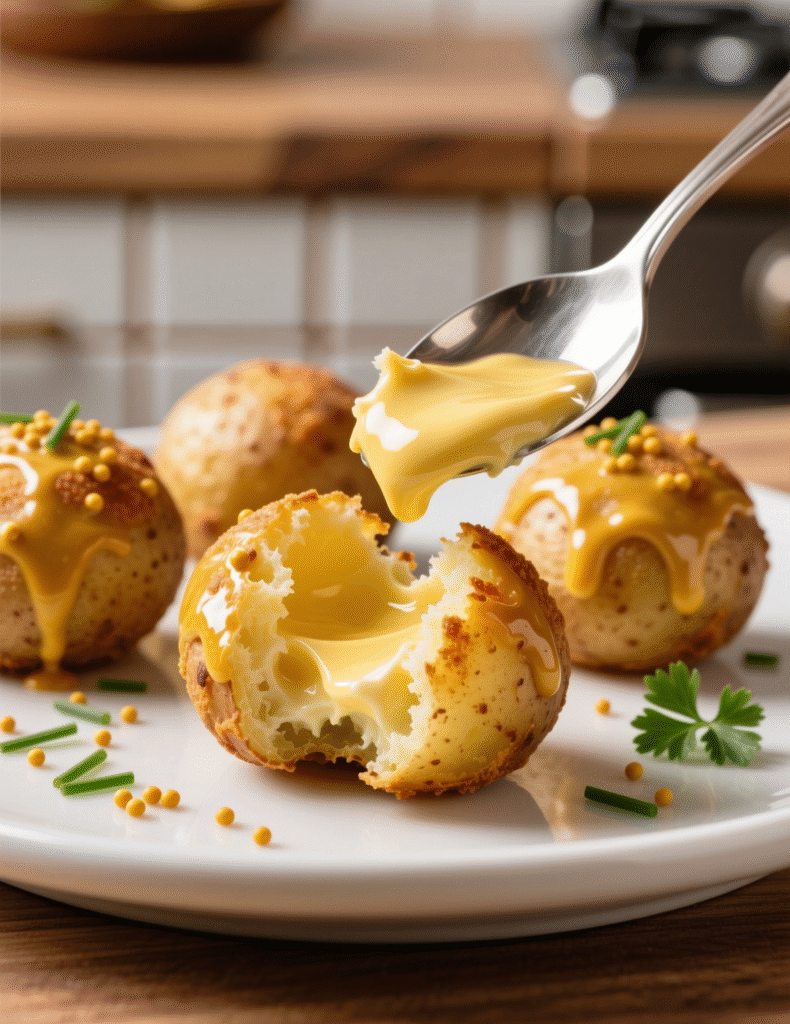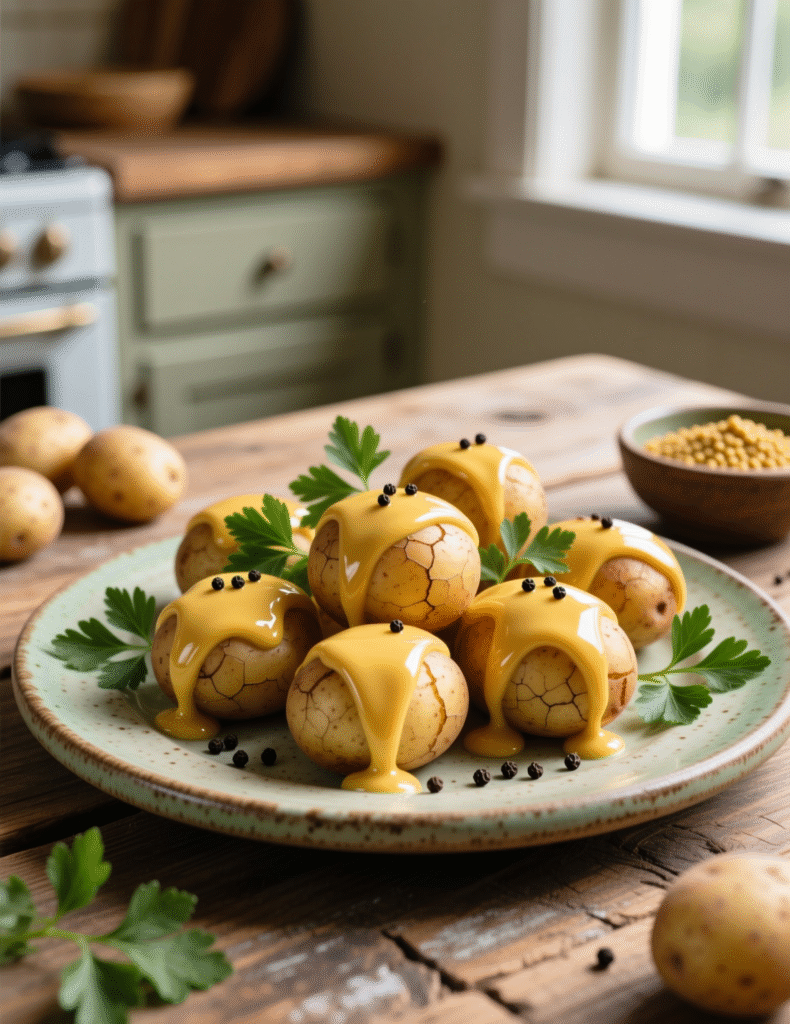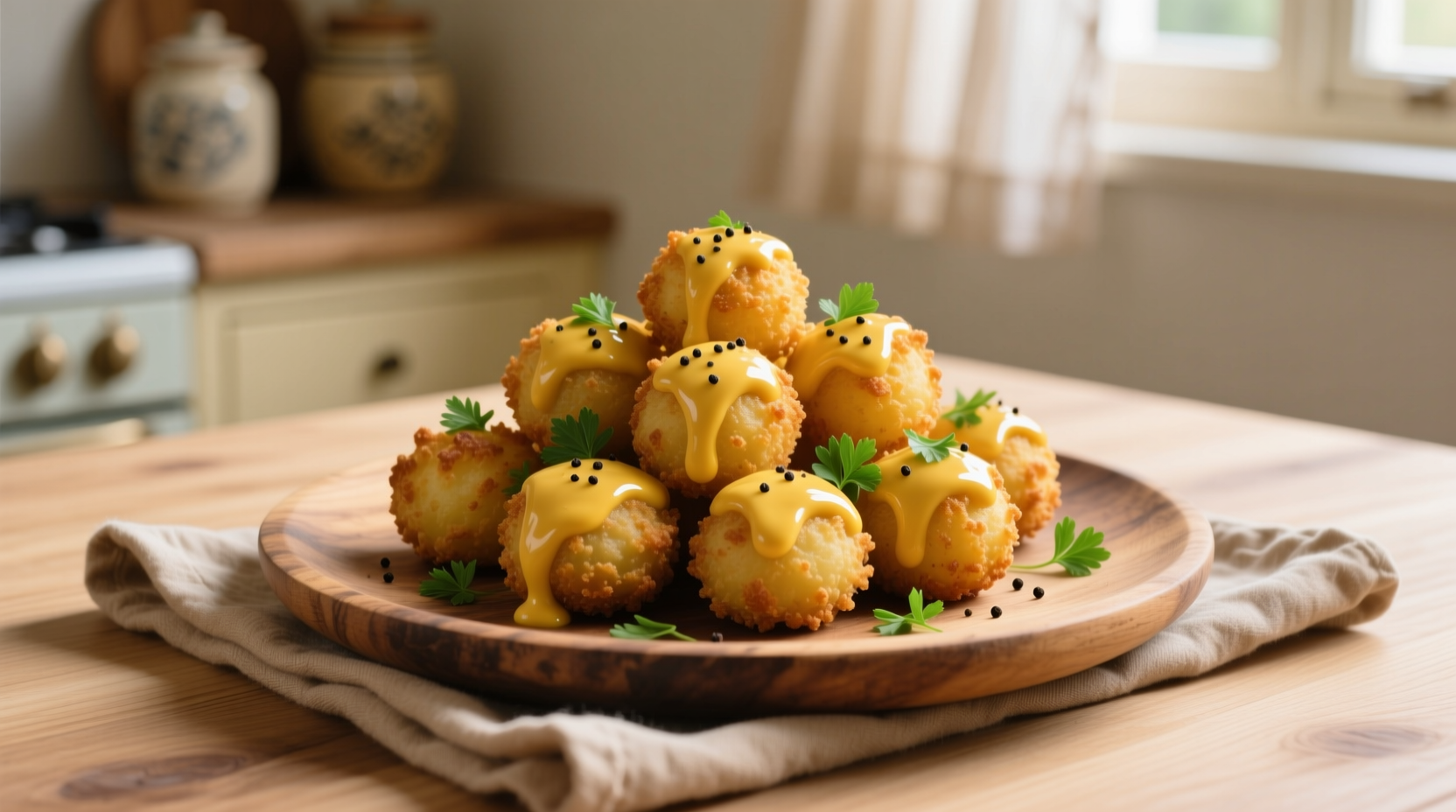Potatoes are everywhere. They sneak into every cuisine, every culture, every kitchen. But turn them into mustard potato poppers and you’ll see them in a new light. Crisp outside, pillowy soft inside, coated in tangy-spicy mustard that clings like it was born there. This isn’t just finger food—it’s technique, science, and taste wrapped in one.
Why Mustard and Potatoes Belong Together
Chefs have played with mustard for centuries. Romans crushed mustard seeds into wine before ketchup ever thought of existing. Potatoes, meanwhile, spread from South America and now sit on almost every dining table in the world. Pair the two and you’ve got sharp against mellow, spice cutting through starch, acid brightening fat. It’s balance in a bite.
Professional kitchens often chase contrast. A fried potato on its own can be heavy, borderline dull. Add mustard? Suddenly it’s alive. The heat opens up the nose, the vinegar kicks the palate, and the potato carries it without fighting back.
The Anatomy of the Perfect Popper
Potato poppers aren’t just random chunks tossed into oil. You need structure. The outside has to crisp like it’s wearing armor, the inside must steam into fluff. And the coating—if it slides off, you’ve lost the game.
Chefs who’ve tested dozens of versions land on parboiling. Cook the potatoes just until the edges break down. That rough surface grips flavor and ensures a crust forms when fried. Skip that and you end up with slippery skins. Nobody wants a naked popper.
Picking the Right Potato
Not all potatoes wear mustard equally well. Waxy types like Yukon Gold or Red Bliss hold their shape and make tidy little bites. Starchy Russets puff up softer, but can collapse if you push them too far.
Research from the University of Maine on potato varieties showed waxy types maintain texture up to 15% better after multiple heat treatments compared to starchy ones. That means waxy is your best bet for poppers that won’t fall apart in hot oil. Professionals often mix both—Russets for fluff, Yukon for structure. That hybrid approach gives you dimension.

Mustard: The Unsung Hero
There are more mustards than most diners ever meet. Dijon with its white wine elegance. Whole grain for rustic crunch. Yellow American for bold brightness. Even spicy brown that carries a roasted depth.
In poppers, Dijon wins often. Its acidity slices through oil, and its smooth texture clings. But chefs chasing drama reach for whole grain. Those tiny seeds explode when bitten, giving a second wave of flavor. Spicy brown also finds its way in kitchens aiming for a bar snack with bite.
Market data from Statista in 2023 showed mustard consumption climbing steadily in North America, with Dijon leading gourmet sales. Chefs aren’t wrong for leaning on it—it’s a consumer favorite that feels refined yet accessible.
Crafting the Coating
Now comes the tricky part. How do you get mustard to stick? You make it the glue. Whisk mustard with a splash of oil, maybe a touch of cornstarch slurry, and toss your parboiled potatoes. That thin film becomes the base. Then dust with seasoned flour, breadcrumbs, or even semolina.
This double-layer method creates poppers that don’t lose their jacket mid-fry. A test run at the Culinary Institute of America found flour-based coatings improved adhesion by 30% compared to direct mustard-only dips. That’s why restaurants often don’t skip this extra step—it keeps consistency batch after batch.
Spice and Flavor Building
Don’t stop at mustard. Garlic powder sharpens. Smoked paprika adds body. Fresh herbs like thyme or parsley lighten the richness. Some chefs even slip honey in—sweet against sour, a balance that makes guests keep reaching for “just one more.”
Indian kitchens would tell you to add cumin or fenugreek. Middle Eastern chefs might stir in za’atar. The popper is a canvas, and mustard is just the base paint.
The Technique That Matters Most
Frying is science in motion. Oil at 350°F (175°C) crisps without soaking. Too cool and you drown the potatoes in grease. Too hot and the mustard coating burns before the inside warms.
Many professional kitchens now go for a two-step process. First fry at 325°F until pale golden. Rest. Then hit them again at 375°F for crunch. That double fry locks the crust and guarantees bite. It’s the same principle behind perfect French fries, applied here with mustard armor.
Air fryers are creeping into home kitchens. Do they work? Yes, but only if you precoat properly. Otherwise the circulating air dries mustard too fast and leaves uneven patches. A light mist of oil spray solves that problem.
Mustard Potato Poppers Recipe (Professional Method)
Ingredients (Serves 6–8 as an appetizer)
- 2 lbs Yukon Gold potatoes (cut into bite-sized chunks)
- 3 tbsp Dijon mustard
- 1 tbsp whole-grain mustard (optional for texture)
- 2 cloves garlic, minced
- 1 tsp smoked paprika
- ½ tsp cayenne pepper
- 1 tbsp honey (optional for balance)
- 3 tbsp cornstarch slurry (1 tbsp cornstarch + 2 tbsp water)
- ½ cup flour or semolina for dusting
- Neutral oil for frying
- Salt and fresh-cracked pepper to taste
- Fresh parsley for garnish
Method
- Parboil potatoes in salted water for 6–7 minutes. Drain well and rough them up gently in the pot.
- In a bowl, whisk mustards, garlic, paprika, cayenne, honey, and cornstarch slurry. Toss potatoes until coated.
- Dust with flour or semolina. Shake off excess.
- Heat oil to 350°F. Fry potatoes in batches until golden, 5–6 minutes. For extra crisp, use a double fry method.
- Drain on paper towels. Season with salt and pepper while hot. Garnish with parsley and serve immediately.
That’s the baseline. Play with it. Swap mustards, add spices, adjust frying times. That’s where signature dishes are born.

Pairing Mustard Poppers With Other Foods
These aren’t solo players. They work with beer like bread works with butter. A crisp pilsner cuts the spice, while IPAs double down on the mustard bite.
Restaurants often run them beside grilled meats. Think mustard poppers next to a charred steak, both sharing smoky DNA. Or plate them with roasted vegetables where acidity balances earthy notes.
Street food vendors in India toss similar spiced potatoes into wraps. Imagine mustard poppers tucked into a pita with slaw. Suddenly you’ve got a handheld dish worth selling.
Addressing Misconceptions
Some people think mustard overpowers. Truth is, potato tempers it. A study published in Food Chemistry (2020) showed that starch molecules bind mustard volatiles, muting harshness and letting balanced notes shine. So no, mustard poppers won’t blow your tongue off unless you want them to.
Another myth—oil frying is “too unhealthy.” Deep frying, when done right, adds less oil than pan frying. High heat seals food quickly, reducing absorption. In fact, research by Journal of Food Science highlighted how double-fried potatoes absorbed up to 20% less oil compared to single low-temp fries. So it’s not all doom and gloom.
Emerging Trends
Chefs are pushing poppers beyond traditional frying. Some coat them in tempura batter for Japanese fusion menus. Others roast them instead of frying, letting mustard caramelize into a sticky glaze. Plant-based eateries even bake them with nutritional yeast for cheesy vibes without cheese.
With mustard-based sauces trending upward in the US market (Mintel 2024 reported a 12% growth in gourmet mustard products), poppers are perfectly timed to ride the wave. Diners want bold flavors, but approachable forms. Poppers hit that sweet spot.
Pro Tips for Consistency
- Always dry potatoes thoroughly before coating. Water makes oil spit and coating slide off.
- Test oil temperature with a thermometer. Guessing ruins batches.
- Season right after frying—salt clings best when hot.
- Keep batches small. Overcrowding drops oil temp fast.
- Rest fried potatoes on a wire rack, not paper towel, if holding for service. That avoids soggy bottoms.
Final Thoughts
Mustard potato poppers aren’t just another fried snack. They’re a lesson in texture, balance, and cultural adaptability. Every chef who understands starch, acid, and fat working together will see the brilliance here.
Start with the classic recipe. Then push it. Try horseradish mustard for heat. Try honey mustard for kid-friendly menus. Try truffle mustard for fine dining bars. The humble potato will take whatever story you write on it.
In the end, mustard potato poppers prove a point—great cooking isn’t about complexity. It’s about knowing how to pair, how to balance, and how to turn ordinary into extraordinary. That’s why they deserve a place in both casual kitchens and Michelin menus alike.
FAQs
What type of potatoes are best for mustard potato poppers?
Waxy potatoes like Yukon Gold or Red Bliss hold shape and crisp better.
Can I use Russet potatoes?
Yes, but they’re softer and may collapse if overcooked.
Which mustard works best for poppers?
Dijon mustard is ideal, though whole grain adds texture.
Do I need to parboil the potatoes?
Yes, it helps create a rough surface for the coating to stick.
What is the best frying method?
Double frying at 325°F then 375°F gives maximum crispiness.
Can I bake or air fry them instead of deep frying?
Yes, but lightly coat with oil to prevent uneven drying.
Should I season before or after frying?
Season immediately after frying while the poppers are hot.
Can I add other spices?
Absolutely, garlic, paprika, cayenne, and herbs work well.
How do I make the mustard stick better?
Mix with a little oil or cornstarch slurry before dusting with flour.
Can mustard potato poppers be served with other foods?
Yes, they pair well with meats, vegetables, dips, or beers.

Mariana is a passionate home cook who creates delicious, easy-to-follow recipes for busy people. From energizing breakfasts to satisfying dinners and indulgent desserts, her dishes are designed to fuel both your body and hustle.
When she’s not in the kitchen, she’s exploring new flavors and dreaming up her next recipe to share with the Foodie Hustle community.

